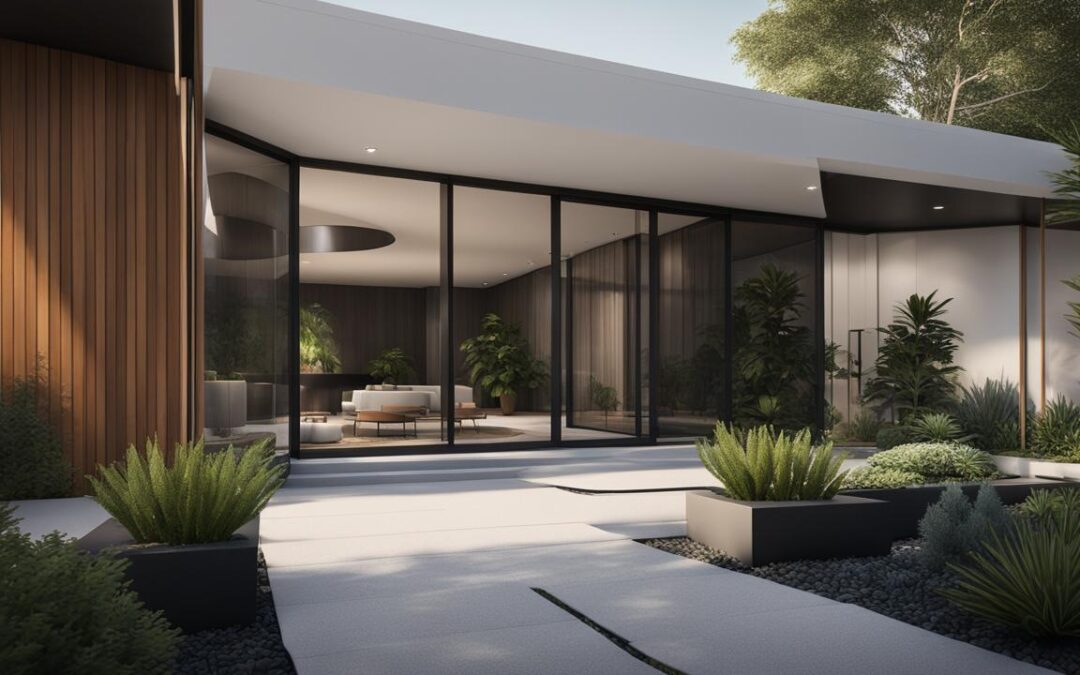During the mid-twentieth century, a new wave of architects emerged, pushing the boundaries of design and shaping the future of modern architecture. These influential architects were at the forefront of the mid century modern movement, creating innovative and iconic buildings that still inspire today. From Eero Saarinen’s TWA Terminal to Richard Neutra’s Kaufmann House, their designs reflect the social and cultural changes of the time. Let’s dive into the world of mid century modern influential architects and explore their lasting impact.
Key Takeaways:
- Mid century modern architecture was a groundbreaking movement that shaped the future of design.
- Influential architects of the mid century modern movement created innovative and iconic buildings.
- Designs by these architects continue to inspire architects and designers today.
- The mid century modern style is known for its distinct features, including clean lines and large windows.
- Architects like Eero Saarinen, Alvar Aalto, and Richard Neutra left a lasting impact on the architectural world.
The Mid Century Modern Style: Recognizing the Key Features
The mid century modern style is characterized by its unique features that distinguish it from other architectural movements. These distinctive elements come together to create the iconic mid century modern look that is cherished and celebrated to this day.
- Flat planes and clean geometric lines: The use of flat surfaces and crisp, angular lines is a defining characteristic of mid century modern architecture. This design approach creates a sense of simplicity and minimalism.
- Large windows to bring in natural light: The incorporation of expansive windows is another key feature of mid century modern homes. These windows allow for ample natural light to flood the interior spaces, blurring the boundaries between indoors and outdoors.
- Changes in elevation to create unique spaces: Mid century modern architecture often incorporates variations in height and levels within a single structure. This creates visually interesting spaces and adds depth and dimension to the overall design.
- Strong connection with nature: The mid century modern style embraces a deep appreciation for the natural environment. This is reflected in the use of organic materials, such as wood and stone, and the integration of outdoor elements, such as courtyards and gardens, into the design.
“The mid century modern style celebrates simplicity, functionality, and the seamless integration of design and nature. It is a timeless architectural movement that continues to inspire and captivate.” – Architectural Digest
Inspiration from Mid Century Modern Interiors
The mid century modern style extends beyond the architecture itself and is often reflected in the interiors of homes and buildings from this era. Some key features of mid century modern interiors include:
- Minimalist furniture: Mid century modern interiors often feature sleek and minimal furniture designs. Clean lines, organic shapes, and a focus on functionality are prominent in pieces such as the iconic Eames lounge chair and the classic Barcelona chair.
- Bold colors and patterns: The use of bold and vibrant colors, as well as geometric patterns, adds a touch of playfulness and personality to mid century modern interiors. From mustard yellows to aqua blues, these colors evoke a sense of nostalgia and energy.
- Natural materials: Mid century modern interiors showcase the beauty of natural materials, such as wood, leather, and metal. These materials add warmth and richness to the overall design, complementing the clean lines and minimalist aesthetic.
- Open floor plans: The mid century modern style embraces open and flowing spaces, with an emphasis on creating a seamless connection between different areas of the home. This allows for a sense of spaciousness and promotes a sociable and interactive environment.
The mid century modern style continues to be a source of inspiration for contemporary architects, designers, and homeowners alike. Its timeless appeal and emphasis on simplicity, functionality, and connection with nature make it a truly enduring architectural movement.
Eero Saarinen: Pushing the Boundaries of Modern Design
When discussing influential architects of the mid century modern design movement, it is impossible to overlook the groundbreaking work of Eero Saarinen. Born in Finland and later becoming a naturalized American citizen, Saarinen made a significant impact on the architectural world with his futuristic and innovative designs. His creations pushed the boundaries of modern design, leaving a lasting impression on the industry.
One of Saarinen’s most renowned projects is the TWA Terminal at JFK airport in New York. Completed in 1962, this iconic structure showcases his unique approach to architecture, with its sweeping curves and futuristic aesthetic. The terminal exemplifies Saarinen’s ability to combine functionality with artistic expression, creating a space that is as visually striking as it is practical.
Another notable work of Saarinen’s is the Gateway Arch in St. Louis, Missouri. Completed in 1965, the arch stands as a symbol of American progress and innovation. Its graceful curves and towering presence create a sense of awe and wonder, solidifying Saarinen’s reputation as a visionary architect.
Through his bold and daring designs, Eero Saarinen contributed greatly to the mid century modern movement. His ability to merge form and function resulted in iconic structures that continue to inspire architects and designers to this day.
Notable Works by Eero Saarinen:
| Building | Location | Year Completed |
|---|---|---|
| TWA Terminal | JFK Airport, New York | 1962 |
| Gateway Arch | St. Louis, Missouri | 1965 |
Alvar Aalto and Arne Jacobsen: Scandinavian Influences in Mid Century Modern Design
Scandinavian design has had a profound impact on the mid century modern movement, and two architects stand out as influential figures in this regard – Alvar Aalto and Arne Jacobsen. Their unique approaches to design, rooted in simplicity and functionality, have left a lasting mark on the world of architecture.
Alvar Aalto, a Finnish architect, transitioned from Nordic Classicism to a more organic modernist style. He believed that architecture should be in harmony with nature and created buildings that embraced their surroundings. Aalto’s designs often featured organic forms, natural materials, and a focus on human comfort and well-being. His iconic works include the Finlandia Hall in Helsinki and the Paimio Sanatorium.
Arne Jacobsen, a Danish architect, was known for his architectural functionalism. He believed that design should be driven by the needs of the user, and his buildings reflected this philosophy. Jacobsen’s designs were characterized by clean lines, geometric shapes, and a minimalist aesthetic. His most famous work, the SAS Royal Hotel in Copenhagen, showcases his meticulous attention to detail and innovative use of materials.
Both Aalto and Jacobsen’s contributions to mid century modern design can still be seen today in the iconic homes and buildings they created. Their emphasis on simplicity, functionality, and a connection with nature continues to inspire architects and designers around the world.
| Architect | Country | Famous Works |
|---|---|---|
| Alvar Aalto | Finland | Finlandia Hall, Paimio Sanatorium |
| Arne Jacobsen | Denmark | SAS Royal Hotel, St. Catherine’s College |
Alvar Aalto: Organic Modernism
Alvar Aalto’s architectural style can be described as organic modernism. He believed that buildings should be in harmony with nature, and his designs often incorporated organic forms and natural materials. One of his most famous works, the Finlandia Hall in Helsinki, exemplifies this approach. The building’s curvilinear form mimics the surrounding landscape, while the extensive use of wood and natural light creates a warm and inviting atmosphere.
Arne Jacobsen: Architectural Functionalism
Arne Jacobsen’s architectural style can be characterized as architectural functionalism. He believed that design should prioritize the needs of the user, resulting in buildings that are not only visually pleasing but also highly functional. The SAS Royal Hotel in Copenhagen is a prime example of Jacobsen’s approach. The hotel’s clean lines, minimalist aesthetic, and attention to detail create a sense of elegance and efficiency.
Ludwig Mies van der Rohe and Richard Neutra: Pioneers of Modernist Architecture
Ludwig Mies van der Rohe and Richard Neutra were two influential architects who played significant roles in shaping mid century modern design. Their innovative and visionary approach to architecture left a lasting impact on the architectural world, inspiring future generations of designers.
Mies van der Rohe, a German-American architect, is best known for his iconic Farnsworth House. This masterpiece of modernist architecture showcases his minimalist and functional design principles. The house, located in Illinois, is a prime example of Mies van der Rohe’s belief in “less is more,” with its sleek lines, open floor plan, and extensive use of glass. It seamlessly integrates with the surrounding natural landscape, blurring the boundaries between indoors and outdoors.
Neutra, on the other hand, made significant contributions to modernist architecture, particularly in Southern California. His designs focused on blending functionality with aesthetic appeal. Neutra’s innovative use of materials such as steel, glass, and concrete brought a sense of lightness and transparency to his buildings. His residential designs, like the Kaufmann House in Palm Springs, demonstrate his ability to create harmonious living spaces that embrace nature and promote a sense of well-being.
“Architecture is the will of an epoch translated into space.” – Ludwig Mies van der Rohe
Legacy and Influence
The works of Mies van der Rohe and Neutra continue to be celebrated and admired in the world of architecture. Their designs exemplify the timeless appeal of mid century modernism, characterized by simplicity, functionality, and a strong connection to the natural environment. The influence of their innovative ideas can be seen in contemporary architecture and design, inspiring architects and designers to push the boundaries of what is possible.
By embracing modernist principles and incorporating them into their designs, Mies van der Rohe and Neutra contributed to the evolution of architectural language and practice. Their emphasis on clean lines, open spaces, and the integration of nature has had a profound impact on the way we perceive and interact with our built environment.
Through their pioneering spirit, Ludwig Mies van der Rohe and Richard Neutra have left an indelible mark on the world of architecture. Their designs continue to inspire and influence architects and designers today, ensuring that their legacy lives on.
| Architect | Famous Work |
|---|---|
| Ludwig Mies van der Rohe | Farnsworth House |
| Richard Neutra | Kaufmann House |
Conclusion
The mid century modern movement revolutionized modern architecture and design, thanks to the visionary work of influential architects. Their innovative and iconic buildings continue to inspire and shape the future of architecture.
From the Scandinavian simplicity of Alvar Aalto and Arne Jacobsen to the futuristic designs of Eero Saarinen, these architects pushed the boundaries of design and paved the way for the mid century modern style. Their creations embraced clean lines, functional spaces, and a strong connection with nature.
Ludwig Mies van der Rohe and Richard Neutra were pioneers of modernist architecture, leaving a lasting impact on mid century modern design. Mies van der Rohe’s minimalist Farnsworth House and Neutra’s innovative designs in Southern California exemplify the timeless appeal of the movement.
Overall, the contributions of these influential architects to modern architecture cannot be underestimated. Their designs and ideas continue to shape the way we think about architecture, making them true game-changers in the field.
FAQ
What is the mid century modern style recognized for?
The mid century modern style is recognized for its distinct features that include flat planes and clean geometric lines, large windows to bring in natural light, changes in elevation to create unique spaces, and a strong connection with nature.
Who was Eero Saarinen?
Eero Saarinen was a Finnish-American architect who played a significant role in shaping the mid century modern movement. Known for his futuristic and innovative designs, Saarinen’s most famous works include the TWA Terminal at JFK airport and the Gateway Arch in St. Louis.
Which influential mid century modern architects hailed from Scandinavia?
Alvar Aalto and Arne Jacobsen were influential mid century modern architects from Scandinavia. Aalto’s work transitioned from Nordic Classicism to a more organic modernist style, while Jacobsen’s architectural functionalism left a lasting mark on the design world.
Who were Ludwig Mies van der Rohe and Richard Neutra?
Ludwig Mies van der Rohe and Richard Neutra were pioneers of the modernist architecture movement and made significant contributions to mid century modern design. Mies van der Rohe is known for his minimalist and iconic Farnsworth House, while Richard Neutra is celebrated for his innovative and functional designs, particularly in Southern California.
What impact did the mid century modern architects have on architecture and design?
The mid century modern movement brought about a shift in architecture and design, with influential architects leading the way. They created innovative and iconic buildings that still inspire today, leaving a lasting impact on the world of architecture and design.





